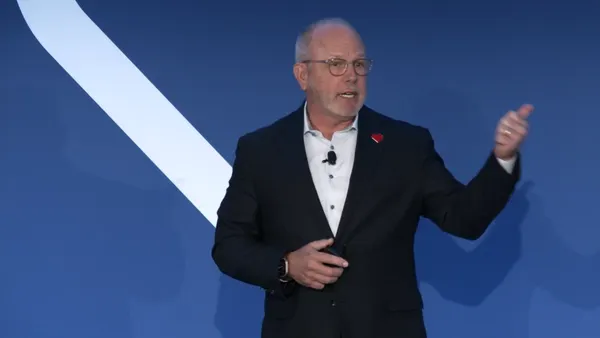Dive Brief:
- Centene’s stock plummeted Friday morning to reach its lowest level since 2015 after the insurer reported second-quarter earnings well below analyst expectations.
- Though Centene’s revenue jumped 22% to $48.7 billion in the second quarter, the company reported a rare loss of $253 million — down from profit of $1.1 billion same time last year — as it struggled with rising medical costs in its Affordable Care Act and Medicaid plans.
- The last time Centene slid into the red was the fourth quarter of 2022. CEO Sarah London said she was “disappointed” with the company’s performance during a Friday call with investors.
Dive Insight:
Centene’s stock has been in a free fall since early this month when the St. Louis-based payer pulled its earnings guidance for 2025 citing unexpectedly high spending on its ACA and Medicaid members. The pressure appears to be affecting payers across the board, with UnitedHealthcare, Molina and Elevance also suspending or lowering their profit outlooks for the year.
But the current situation is trickiest for companies like Centene, which focus almost exclusively on government healthcare programs — where the steepest costs are bubbling up.
Centene is the largest marketplace insurer, with 5.8 million members in 29 states, and the largest Medicaid managed care organization, with 12.8 million members in 30 states.
As such, the insurer’s second quarter meltdown was “disappointing but not particularly surprising,” wrote J.P. Morgan analyst John Stansel in a note Friday.
Centene's stock is down 56% year to date to pre-pandemic lows
Centene’s medical loss ratio, a marker of spending on patient care, reached a whopping 93% in the quarter, up from 87.6% in the same period last year. Insurers in government programs try to keep their MLRs as close to 80% or 85% as possible to comply with regulatory requirements, but a lower MLR is always better.
Centene said the MLR spike was due a troubling shift in the ACA marketplace risk pool, driven by a few factors.
For one, a high percentage of healthy members dropped their ACA plans during open enrollment for 2025, probably as a result of stricter program integrity measures preventing autorenewal, Centene executives said on the call.
In addition, first-time enrollees in Centene’s ACA plans through its Ambetter subsidiary tended to be sicker, which could be due to former Medicaid beneficiaries losing coverage following the pandemic and opting into the ACA exchanges. Centene also saw a broader step-up in marketplace utilization combined with more aggressive provider coding, according to London.
“Together, these dynamics have shifted the morbidity of the market in some states as much as 16% to 17% year over year. Ultimately, Ambetter was underpriced for this morbidity shift,” the CEO said. “This is obviously a disappointing outcome.”
All told, the pressures increased how much Centene expects to lose in risk adjustment payments, which reimburse insurers if they cover sicker enrollees than other plans in the ACA exchanges, this year.
On July 1, when Centene pulled its earnings, the insurer disclosed that it expected risk adjustment reimbursement to be $1.8 billion lower this year than it had previously thought. But Centene hiked that expectation to $2.4 billion on Friday after reviewing more comprehensive data.
Utilization is also trending up in Medicaid, especially in behavioral health and home health services and high-cost medications like cancer drugs and gene therapies, executives said.
Hopefully, states will increase their Medicaid rates to cover the trend moving forward, and potentially provide retroactive increases for services with peaking spend, CFO Drew Asher said on the call.
As for the ACA, Centene plans to refile its plan bids with states to provide marketplace coverage next year to account for the higher acuity. The company has already refiled in 17 states and plans to submit fresh bids in its remaining 12 states over the next week, according to Asher.
“As we sit here today we expect to make meaningful upward 2026 rate adjustments reflecting this data across our marketplace footprint,” Asher said.
Centene’s 2026 bids also assume that more generous subsidies for ACA coverage that have contributed to record enrollment cease at the end of this year. The future of the subsidies is an open question in Washington, though the insurance industry is bracing for their expiration — and additional turmoil stemming from Republicans’ “Big Beautiful Bill” signed into law earlier this month.
The law overhauls Medicaid and the ACA to align with GOP priorities, including funding cuts and the implementation of work requirements in Medicaid and stricter eligibility verification in both programs. It’s a major headwind for insurers, given the law is expected to cause 10 million Americans to lose health insurance — further shaking up already volatile risk pools.
During the investor call, London stressed that law’s biggest provisions will be gradually phased in, giving Centene a chance to work with states to implement the policies to mitigate any drastic operational changes or coverage losses. But the law is still another source of uncertainty for the insurer as it works to resuscitate profits.
“Yes, we have to navigate a major unanticipated shift in the marketplace risk pool in 2025 as well as the dislocation between Medicaid rates and underlying medical costs plus regulatory changes in 2026 and beyond,” Asher said.
But “this is fixable,” the CFO added.
Centene provided new earnings guidance during the call. The insurer now expects full-year adjusted diluted earnings per share of $1.75, down from its previous target of at least $7.25.














